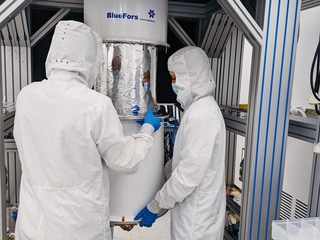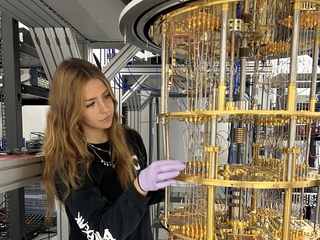Vasilisa Malenkiy ‘27, an undergraduate physics student in the David Moore lab working on the SIMPLE experiment, is spending her summer at SLAC National Accelerator Laboratory, operated by Stanford University and the DOE. At SLAC, she is conducting nuclear physics research developing instrumentation for the Beryllium Electron capture in Superconducting Tunnel junctions (BeEST) experiment—an effort to search for sterile neutrinos and physics beyond the Standard Model—with the Neutrino (nEXO) and Dark Matter Quantum Information Science (DMQIS) groups, under the mentorship of Brian Lenardo.
Malenkiy explained, “The BeEST experiment searches for sterile neutrinos (𝜈s) —hypothetical particles that interact only via gravity, are compelling dark matter candidates, and could explain other beyond-the-Standard-Model phenomena—by precisely measuring the recoil energy of lithium nuclei in ⁷Be → ⁷Li electron capture decays.”
Malenkiy continued, “If a heavy 𝜈ₛ is emitted, energy conservation causes a small drop in recoil energy—a signature that BeEST’s high-resolution superconducting tunnel junction detectors are tailored to detect. To isolate this energy shift, BeEST uses a γ-ray “tag” from a special subset of decays: about 10% of ⁷Be decays leave ⁷Li in a short-lived excited state, which emits a 478 keV γ-ray as it relaxes. Detecting this γ-ray yields a cleaner recoil sample and sharper energy resolution, enhancing BeEST’s sensitivity to the tiny energy spectrum shifts expected from 𝜈ₛ emission.”
Malenkiy said, “This summer, I commissioned and characterized a new sodium iodide (NaI) scintillator array for γ-tagging in BeEST. I built the readout electronics, calibrated the detectors, gain-matched their responses, and measured accidental coincidence rates around 478 keV to better understand the γ-ray background. The array will be deployed at Lawrence Livermore National Laboratory (LLNL) to sharpen recoil measurements and boost BeEST’s sensitivity to sterile neutrinos.”
“I also installed and tested a data acquisition system (DAQ) for a new class of High-Voltage electron-Volt (HVeV) detectors—ultracold silicon devices that measure nuclear recoils through crystal vibrations rather than superconducting currents. I completed end-to-end DAQ testing and integrated the system into a dilution refrigerator at SLAC, preparing BeEST for its next generation of precision recoil measurements.”
Malenkiy added, “I loved researching as part of a collaborative experimental team at SLAC this summer. Every day brought something new and entertaining—from building and characterizing detectors in the lab, to working with ultracold dilution refrigerators in the cleanroom, to collaborating with mentors, graduate students, interns, and visiting researchers. Above all, working alongside others equally passionate about physics made the experience highly energizing and deeply rewarding. This summer has cemented my commitment to pursuing a research career at the intersection of nuclear, particle, and quantum physics, and I’m excited to carry the fire it ignited back to Yale and beyond.”



